Advantages and disadvantages

The advantages of wood burning models for the home are obvious. You will not need to heat around the clock. One loaded furnace furnace will burn for 8-10 hours. The main disadvantage of operating this type of furnace, oddly enough, is their high efficiency. The fact is that the flue gases at the outlet, giving off their energy, have a very low outlet temperature (130 - 180 C). That's why:
- In such devices for long burning, the thrust is much less;
- A lot of condensable substances (water, tar, soot) form in the chimney and if the chimney is installed incorrectly, this can lead to frequent blockages.
The listed problems have been solved technically for more than 20 years of experience in the widespread operation of such heating technologies. Standard pipes and chimneys are produced by manufacturers, the installation schemes are described in the instructions, the declared passport parameters from bona fide suppliers correspond to reality.
Model overview
When deciding which wood-burning stoves to choose, it is worth studying prices and reviews. Flammable materials must not be placed near the heat exchanger. In this case, the distance from the wall surface to the door should be at least 1.1-1.3 meters.
The price of products depends on the power, design and specific manufacturers. Equipment with forged products is suitable for a variety of interiors. To warm up a garage or summer cottage, you can choose a simpler model.
Cast iron structures are more expensive, but superior in quality to steel equipment. Most often you can find French and Italian manufacturers. Of the Russian models, Hephaestus and Meta are popular.
 Some models have a door on the side for loading firewood
Some models have a door on the side for loading firewood
Sauna stoves are Finnish and Russian. Among the Finnish companies, it is worth highlighting Harvia and Castor. Zhara stands out from the Russian designs. The Russian company Termofor offers models made of heat-resistant material, which are distinguished by a modern design. The budget options include Teplodar. For garages, self-made structures are often used: a stove or bubafon.
It should be borne in mind that the warranty from the companies does not apply to elements, the wear of which depends on the quality of the fuel. These are grate bars, vermiculite gaskets and lining.
The table shows the models of some manufacturers and the cost for them.
| Image | Manufacturer | Model | The volume of the heated room, m3 | Cost, rub. |
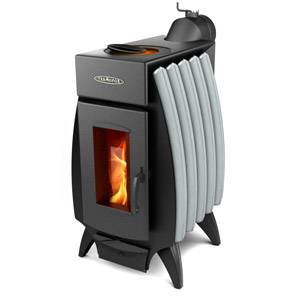 |
Termofor, Russia | Fire-battery 5 | 100 | 14 000 |
 |
Termofor, Russia | Cinderella | 50 | 6 700 |
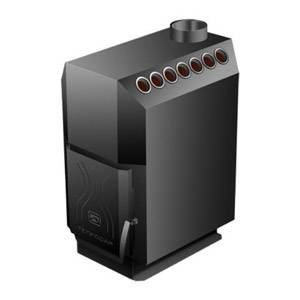 |
Teplodar, Russia | Top Model 140 | 100 | 12 500 |
 |
Ermak, Russia | Ermak-stoker | 300 | 15 600 |
 |
Buleryan, Canada | Buleryan 02 | 400 | 9 200 |
 |
Guga, Serbia | Prometheus | 250 | 26 700 |
 |
Meta, Russia | Neva | 100 | 18 000 |
 |
ABX, Czech Republic | Kaburek | 120 | 30 000 |
Metal structures are very different from brick stoves for wood-fired summer cottages. Photos allow you to see different options. All metal models are convectional. In this case, the stove heats the room not only with the help of radiation, but also with the use of air, which moves between the walls of the casing. To reduce the risk of flue emissions, the structures are equipped with special nozzles.
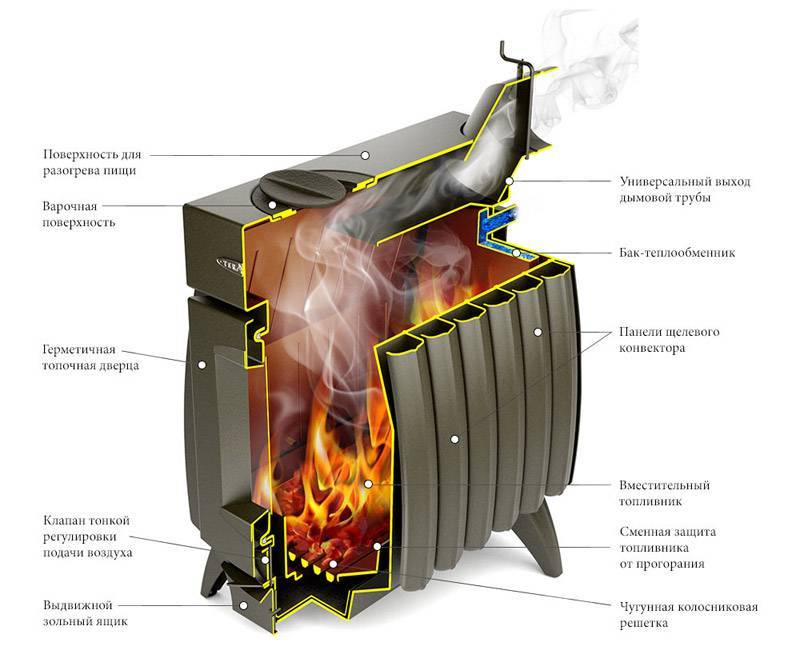 Almost all factory furnaces have such a device.
Almost all factory furnaces have such a device.
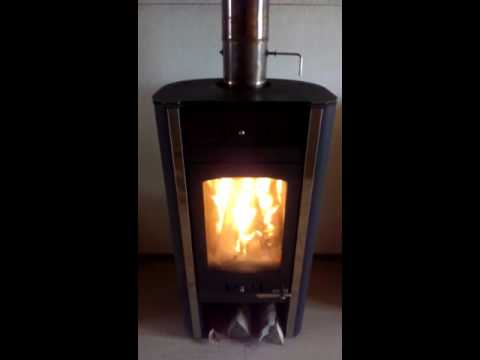
Arrangement of a long-burning stove in a private house
During installation work, you will need to closely adhere to the operating instructions provided by the manufacturer. General installation recommendations:
- The location of the stove in the house is determined depending on the principle of its operation:
- Air heating models are installed taking into account the movement of heated air flows. A distance of 1 m is left to the walls, which is necessary to ensure the operation of the furnace with the necessary amount of cold air.
- Models with a built-in water circuit are located in any part of the house that meets fire safety requirements.
- A prerequisite for operating a long-burning stove is good ventilation in the house. The room where the stove is installed must have opening windows, the ceiling height is not less than 2.2 m. Supply and exhaust ventilation must provide three times air exchange in the room within an hour.
- It is better to put a stove in the house in a room with floors made of non-combustible material. Otherwise, the wood floor under the stove is covered with brickwork, iron or thick tempered glass.
Air heating stoves, if necessary, are connected to a corrugated metal pipe, through which air enters the different rooms of the house. For better circulation of air masses, a fan is installed inside the air ducts.
Furnaces with a water circuit are connected to the heating system. A security group is required.
What are the advantages of ovens
high quality
Advantages of autonomous heating of a private house using a long-burning stove:
- Self-installation of the oven is possible.
- Working time from one bookmark of firewood is 6-8 hours.
- Possibility of choosing the principle of heating: air or water.
- Fast warming up of the room.
- Relatively low cost.
- Additional functionality.
country house
What are the disadvantages
- Demanding fuel quality - firewood burned in a gas-generating furnace should not be damp, the maximum moisture content is no more than 20-25%.
- Cons associated with air heating equipment - convection ovens are limited to heating one room. To warm up adjacent rooms, you will need to install a duct system, which is associated with additional material costs. Models with a water circuit do not have these disadvantages.
Oven or still a boiler
solid fuel boilers
- Heat transfer - furnaces and boilers have high efficiency up to 92%. Convection models are somewhat inferior in efficiency to the series with a water heat exchanger.
- Cost - Stoves are cheaper than boilers.
- Functionality - boilers are designed exclusively for heating. Ovens (some models) are equipped with a hob and oven, which increases their application possibilities.
- Purpose - in a house of permanent residence, as the main source of heat, it is better to install a solid fuel boiler. Stoves are more efficient when heating sparsely heated buildings.
The rapid development of the construction of private residential buildings in recent years has led to a radical change in heating means and structures used in this sector. Until recently, the wood-burning stove in the house seemed to be an anachronistic relic of the past, and the fireplace and fireplace stove were considered more of an interior item than heating appliances.
The stove was made by an eminent stove-maker, the fireplace made by a famous master, although they seemed to be a source of pride, were rarely used for their intended purpose. Today, industry, both world and domestic, offers a number of utilitarian approaches to the design, installation and arrangement of houses, which make it possible to consider this type of heating for heating living quarters not only quite modern and convenient, but also quite effective.
Cast iron stoves: advantages and disadvantages
Cast iron heating units have proven themselves from the best side, due to the ability of cast iron to accumulate heat and give it away for some time after the fuel has completely burned out. In addition, the list of advantages of a cast iron stove includes:
- Corrosion resistance and durability. Gray cast iron is characterized by a high carbon content and does not rust when exposed to condensate, therefore, such a stove for a summer residence is not afraid of cold kindling and can be used irregularly during the winter season without harm. A cast iron firebox is not damaged by acids formed when ash and soot are mixed with condensate moisture.
- Compact and attractive design. Wood-burning cast-iron stoves look aesthetically pleasing and stylish, organically fit into the interior of the room. The unit does not take up much space in a room or kitchen of a country house.
- A variety of models differing in functionality.
The disadvantages of heating units of this type include the high price. Cast iron stoves cost one and a half to two times more than steel ones. Also the disadvantage is:
- large weight of cast iron products, which complicates and increases the cost of delivery and installation of the heater;
- the tendency of cast iron to crack as a result of a temperature shock - you should avoid getting cold water on the hot surface of the heating and cooking stove;
- brittleness of cast iron - the material is capable of splitting with a strong point impact with a solid object.
Cast iron stove has a high price
Country stoves are inferior in efficiency to boilers, since they are capable of fully heating only one room, emitting thermal energy and providing convection. In the neighboring rooms, heat will only come with heated air. If the unit is supposed to be installed in a house with several rooms, it is recommended to choose a model with a built-in water circuit or, in addition to the oven, use electric convectors in the adjacent rooms, which will help maintain a comfortable temperature level.
Purpose and features
The very name of the equipment speaks about the purpose of the equipment - heating and cooking devices are used for simultaneous heating of rooms and cooking or heating food.
Thus, just one heating device can bring enormous benefits to the household, replacing both the radiator and the gas stove at once. And, if you also use ovens to heat water, even the lack of hot water supply can be compensated.
Equipment classification
All heating and cooking devices differ in the following ways:
- in terms of power (most often it is small, 6–120 kW, and is designed to heat the room in which the equipment is installed, and one or two adjacent ones);
- by design (some stoves are finished with decorative ceramic tiles, others with natural stone, others have a fireplace screen through which a burning flame can be seen);
- according to the time of long burning, the stoves are divided into 3 categories (up to 3 hours, 5–8 hours and from 9 hours and more), which allows to reduce fuel costs;
- in size, which can be both compact (for the ability to move the furnace) and large enough (for high-performance units with a capacity of up to 20-25 kW).
The decorative properties of heating and cooking fireplaces can be improved through the use of glass of a special shape - convex, vertically oriented, having 2 or 3 planes, making it possible to observe the fire from several sides.
Advantages and disadvantages
The main advantages of heating and cooking stoves are:
- a high level of thermal efficiency, due to which the premises heat up quickly with low fuel consumption;
- the ability to use the equipment all year round (in winter, mainly for heating housing, in warm weather - in order to receive hot food and water;
- economical use of firewood, allowing them to be put into the firebox no more than 2-3 times a day, and also to make not such large reserves of fuel, which is required for conventional stoves;
- the relatively low cost of both the device itself and the energy carrier used for its operation;
- resistance to high temperatures and corrosion, increasing the operating life of the furnaces;
- the possibility of using coal briquettes in the absence of firewood;
- a wide range of models of domestic and foreign production, allowing you to choose equipment with the required dimensions, power, appearance and a suitable price.
The main disadvantage of furnaces is their high fire hazard, which requires compliance with certain rules during their installation. For example, a special location in the room, the installation of a special base for the device and in front of its firebox, the installation of a chimney for the removal of combustion products. The fuel for this equipment (wood or coal) requires sufficient storage space. And you have to put it in the firebox manually - the possibility of working in automatic mode for heating and cooking stoves is not provided.
Analysis of the models on the market
Long-burning furnaces are produced both in Russia and abroad. At domestic points of sale of heating devices, you can easily select high-quality, economical and functional equipment.
Fire-battery
The Novosibirsk company "Termofor" produces several types of heating stoves. The long-burning furnace "Fire-battery" and the furnace with a water circuit "Fire-battery-B" have long won the sympathy of Russian summer residents and owners of private houses. Within the same model range, there is a range of products with numbers 5, 7, 9, 11. Each number indicates the number of pairs of convectors installed on the sides of the oven. For example, the "Fire-battery 9" unit is made using 9 such pairs. Each model has its own dimensions, functions, power and weight. Depending on the model, there is one or more cooking zones on the top of the oven. If in the name after the number there is still the letter "B", then this means that the oven is with a water circuit.
Consider the characteristics of one of the most powerful in this line: Fire-battery 9.
- The volume of the heated room: 200m³.
- Furnace weight: 62 kg.
- Depth: 805 mm.
- Width: 370 mm.
- Height: 760 mm.
- Chimney diameter: 120 mm.
- Glass in the firebox: Yes.
- Heat exchanger: No.
- Has a hob.
- Average price of the oven: 15,000 rubles.
The manual for the Fire-Battery ovens in PDF format can be downloaded.
Fifth statics
Another product of the Novosibirsk company is the Statica Kvinta fireplace stove, a modern-looking device that combines the functions of a classic fireplace and a heating and cooking stove. Long and continuous burning is ensured by the possibility of filling the firebox with wood through the high door to the very top. Its capacity will be enough to heat a room with a volume of up to 150 cubic meters. m. Easily adjusting the air flow with the damper, you can choose both an economical and a more enhanced mode of operation of the fireplace stove. Due to the tightness of the cast-iron doors, a clear control over the intensity of combustion is achieved.
The wood-burning interior heating and cooking stove-fireplace "Termofor Statica Kvinta" has two independent doors. The lower door allows you to regulate the air flow, which allows you to choose the mode of operation from intensive to economical. It also provides access for cleaning ash.
The upper door has a heat-resistant glass through which the entire combustion process is visible. There is also a "clean glass" system, which allows you to protect the glass from soot and keep it clean during the entire burning of the wood.
Features and Benefits
- The distinctive corporate design will enhance the interior.
- Beautiful bay window glazing allows you to watch the fire from different angles.
- Compact dimensions allow installing the stove even in a small room.
- The vertical arrangement of the wood ensures even burning and allows you to get a beautiful high flame.
- The high door of the firebox allows you to fill the stove with wood to the maximum for long-term continuous burning.
- The developed ribbing of the firebox increases heat transfer and enhances the rigidity of the stove.
- The double shielding of the firebox effectively dampens harsh heat radiation.
- Hermetically sealed cast iron doors allow precise control of the combustion intensity.
- Large diameter cast iron hob for all sizes of cookware.
- Top firing possible thanks to heated top air supply.
- Blowing hot air over glasses protects them from smoke.
- Thanks to the deep ash drawer, it is not possible to clean the ash for a long time.
- Universal chimney outlet to the right or left.
Such a stylish unit with a beautiful bay window glazing and a characteristic corporate design is able to create a special warm atmosphere in any interior. Compact dimensions and the possibility of an angular arrangement of the device allow the installation of a fireplace stove and at the same time save useful living space.
Download instruction manual
You can download the operating manual for the wood-burning interior heating and cooking stove-fireplace in PDF format.
Many regions of the country have a harsh climate, therefore, the arrangement of the fuel system is of great importance. Furnaces for houses on wood burning for a long time are becoming indispensable helpers for suburban housing and summer cottages. They are in demand in places where there is no access to other energy sources. Conventional stoves are not as efficient as long-burning wood-fired models. With the use of such equipment, there is no need to build a furnace with your own hands. A long burning stove allows you to create more convenient, beautiful and cheaper heating.
A beautiful stove can be a great decor element.
What is the best wood for the stove?
Many homeowners are interested in knowing how to properly heat the stove with wood in winter. You can choose firewood of different types of wood. Hardwoods are especially suitable, which have good heat transfer and long burning time. Such rocks are characterized by a dense structure and a content of resinous components. This contributes to less soot settling on the pipes.
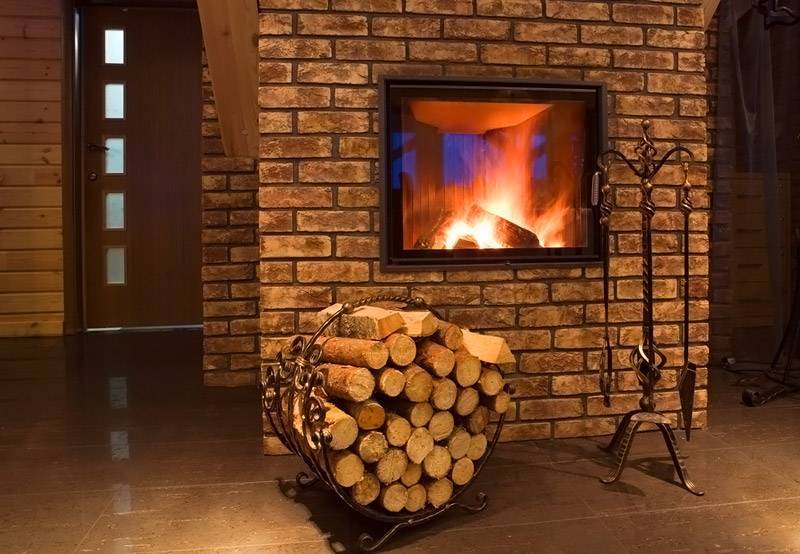 Firewood is the simplest raw material for heating
Firewood is the simplest raw material for heating
The following options are worth considering:
- long-lasting species include oak, but this is the most expensive option. When choosing such wood, it is worth choosing middle-aged trees;
- birch logs quickly flare up and form a good heat, but it is better not to use them for the oven, since they contain a lot of resin;
- less heat transfer from conifers. Due to the resin content, such wood is characterized by the "shooting" of coals;
- aspen burns for a long period of time, but differs in a small heat transfer. At the same time, a large amount of soot and soot is not formed;
- Alder wood has beautiful flames and also maintains heat. Low resin content protects against heavy smoke;
- it takes longer for linden wood to ignite than other species, but then the logs begin to emit a strong heat.
 Firewood for heating must always be dry.
Firewood for heating must always be dry.
The combined method of kindling is popular. For this, several apple-tree logs are used together with aspen or birch firewood. At the same time, the stove heats well and at the same time cleans the chimney. There are wood types that are suitable for construction work and some for heating. When choosing raw materials, heat transfer, combustibility and the amount of ash are of great importance.
Application features
If wood stoves are bought for heating a private house, then the manufacturer always adds instructions to them, which allows you to get acquainted with the basic rules of work. Such documentation contains absolutely all comments, even the recommended fuel moisture content is spelled out. But even a careful study of the instructions and adherence to all operating rules does not always allow you to avoid troubles.
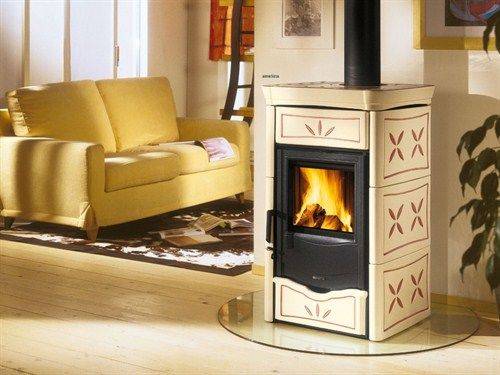
- When installing the device, pipes must be collected against the movement of gases, this will eliminate the settling of soot on the floor of the room;
- You should not be smart with the installation diagram, it should be simple so that, if necessary, it can be easily disassembled;
It should be borne in mind that the surface of the device is very hot, and the space near it should be safe and inaccessible to children.
Homemade long burning metal stove
From the materials we need:
Homemade stove elements
- A round barrel that will serve as the body of the furnace. Do not use an old corroded barrel - this oven will not last long. The barrel must have thick walls to withstand higher temperatures.
- Steel pipe.
- Building level and marker.
- Hammer.
- Hacksaw for metal.
- Mallet.
- Channel.
- Axe.
- Steel sheet.
- Welding machine.
The process of work will be associated with a certain noise and dirt, so it is better to assemble such a stove on the street or in the garage.
- Determine the location of the homemade oven.
Cooking a body from a steel barrel
Given its low external qualities, it is better to use a non-residential area for this. If the dacha is equipped with only one room, then the stove can be placed in the corner, creating a small decorative screen that covers the structure. Take a metal barrel and, using a marker, mark the top with the markings along which you will need to cut off the top. Determine immediately how much tank volume is needed for laying firewood. The more wood you put in, the longer the stove will burn out.
Remove the top and weld on the legs
Preparing a hole for a branch pipe
Only first you need to cut off the sidewall from it. You will get a steel circle. Using the disc nozzle on the grinder, grind this circle from all sides - it should smoothly enter the inside of the barrel.
We make a hole in the center of this circle, the diameter of which is equal to the diameter of the steel pipe.
Take the channel and mark on it for 4 parts, which, like blades, will be welded to the steel circle of the cover.
Cut the channel into 4 parts with a grinder and weld them at the same distance along the diameter of the steel circle.
Weld the steel pipe in the center of the pressure circle.
Welding the pipe to the steel circle
Making the oven lid
Hole in a circle
Oven base
Given the low weight of the steel structure, there is no need to build a separate foundation for the furnace. It will be enough to lay out a brick base that is larger than the oven itself. We connect a homemade stove to the chimney.
Connecting the stove to the flue pipe
One rule applies here - put the pipe sections on top of each other in the opposite direction of the smoke movement.
In principle, this can be considered a structure ready for use. But during the heating process, you can notice how much the walls of the stove are heated. Therefore, for ease of use and safety of life, it is better to equip a protective screen.
Brick protective shield
The protective shield can be folded out of bricks. For this, ordinary red brick is suitable, which should be laid out at a distance of 10-15 cm from the walls of the oven. The brick screen, in addition to protection, will increase heat transfer even after the stove burning stops.
If you plan to install a homemade long-burning stove in a separate boiler room by connecting a heating system to it, then there will be no point in installing a brick protective screen.
- Remove the cover and take out the device that presses the wood.
- Load fuel up to the set mark. The critical line is the chimney pipe. The firewood should not be higher than the level of its placement.
- The better the wood is pressed and tamped, the greater the combustion process will take place in the firebox. Therefore, make sure in advance that the firewood is not large and, laying them in rows, lay chips between them.
Pack the wood well and fill the space with sawdust
The moisture content of the wood should not exceed 20%. Therefore, if you are taking firewood from a shed or cellar, provide an adequate supply of firewood, which will lie in a dry house for a while. A stylish firebox that you can build with your own hands will allow you to beautifully equip such a storage system.
Put kindling material on top of the firewood. It can be sawdust, paper, brushwood.
Cast iron units
If you need a reliable, durable stove, then you should consider models made of solid steel or cast iron. Steel, of course, is a cheaper material; furnaces are lighter in weight. But cast iron - resistant to corrosion and high temperatures and therefore the most durable. Their price is higher than that of steel.

By design features, cast iron furnaces are different - rectangular, cylindrical, square, extended upward, low.
Today, stoves are produced with an original design, so they can perfectly fit into any interior. Unattractive iron structures are a thing of the past. They were replaced by ergonomic units covered with special paint, reliable and with excellent performance parameters.
Rating of long burning ovens

Focusing on the variety of technical parameters and the price / quality ratio, we can distinguish some manufacturers on the market. From domestic enterprises, the Teplodar ovens can be distinguished.
This is a fairly reliable product, distinguished by thoughtful design and execution. From foreign manufacturers, we can recommend Finnish ovens, as well as the products of the Canadian company Buleryan and its joint ventures. The list of recommended manufacturers on the market looks like this:
- Teplodar;
- Thermophore;
- Ermak;
- Finnish stoves;
- Buleryan.
In conclusion, a little more detail about the products of these companies with a short description of the furnaces that they offer.
Furnace selection recommendations
Regardless of what the heat source will be, it must provide complete heating of all areas of the house. Whether a stove for a summer residence is capable of this, will tell its characteristics:
- power;
- heat transfer;
- Efficiency (coefficient of performance).
Power is an indicator of the properties and efficiency of the furnace, but you need to understand that in different modes of operation of the heat source, it will show different power. And yet this is the main criterion to be guided by when choosing heating equipment.
On average, heating 25 m3 of heated space requires 1 kW of rated power. They also take into account the state of the house, its ability to retain heat. In this regard, the average equipment efficiency is adjusted in one direction or another. Taking into account the state of the house, 1 kW of heating equipment power is sufficient for heating:
- 14-15 m3 of a building without thermal insulation located in a cold climatic zone;
- 25–27 m3 in a house with thermal insulation in a region with a cold climate;
- 33–35 m3 in a heat-insulated building in a warm climatic zone.
The next important indicator of equipment efficiency is efficiency, the value of which is calculated by the formula: a-b = efficiency
Where "a" is the amount of thermal energy that is obtained with the complete combustion of the fuel;
"B" is the amount of heat energy actually transferred by the stove to heat the room.
The characteristics of the furnaces directly depend on their geometric parameters and material of manufacture. Therefore, large-sized heating devices are not always more efficient than small-sized ones, since the latter can be made of a material with a higher heat transfer.
What to choose from: types of furnace equipment for summer cottages
Information about the effectiveness and features of popular stoves for summer cottages will help determine the choice of heating equipment. It is installed once and for many years, so the choice is thoughtful and thorough.
The choice of stove must be approached thoroughly.
Russian
A real Russian stove is a large and heavy construction that requires a spacious room. Today, the primordially Russian model has been modernized for modern conditions and has smaller geometric parameters, but still heats large areas just as efficiently.
Russian stoves are equipped with stoves, ovens and stove benches. The efficiency of brick structures of this model is high, not less than 75%. The peculiarity of the stove lies in its design, which consists of a system of channels and a chimney.Therefore, it quickly heats up, accumulates heat and gradually releases it, thereby maintaining a stable temperature in the room.
The originally Russian model of the furnace has been modernized for modern conditions
Dutch woman
The Dutch woman is one of the most efficient and therefore popular country stoves. Its design has its own characteristics:
- a winding system of channels located one above the other;
- absence of a grate;
- a variety of shapes of the furnace body: round, semicircular, rectangular, with ledges;
- the walls are laid in 1 brick, which leads to a low weight.
The Dutch woman quickly warms up the room and keeps it warm for a long time. Differs in economical fuel consumption. It can be equipped with a stove and a stove bench.
The oven can be equipped with a cooking hob
Brick Swede
The Swede is a spectacular and cozy stove with an efficiency of at least 60%. The structure is lightweight, therefore, does not require a large amount of materials for construction. The Swede is one of the best stoves for heating a country house and a residential building. Ideal for small buildings, suitable for year round heating.
With a water circuit
The main "minus" of any stationary furnace is the weak heating of the distant zones of the structure. The problem is solved by installing a heating system consisting of a heat source, piping and radiators. The system can be single-circuit or double-circuit, but in any case it requires a coolant with a constant temperature.
The system can have one or two circuits
Furnaces with a water circuit are designed to solve this problem. The design of this heating equipment includes a boiler - a container with water, which is heated by the stove and fills the pipeline. The circulation is provided by a special pump. A furnace of this type can be brick or metal. Regardless of the material of manufacture, this is the best choice for heating a summer cottage.
Fireplace stove
The fireplace stove is highly decorative, attracts with the opportunity to feel the warmth of a living fire and enjoy it. There are many models of this type of structure. You can choose the most suitable one in terms of power and visual appeal.
There are fireplace stoves of various designs on the market
Small-sized potbelly stoves
Potbelly stove is a small metal stove for a summer residence, which is easy to assemble and install. Most of the infrequently visited country houses are equipped with just such stoves. They are quite economical, unpretentious in maintenance, capable of well heating a small room.
With hob
Models with hobs are the most convenient to use. The ability to cook food on the stove saves electricity and will help out in the absence of it. Therefore, practical summer residents choose just such a multifunctional heating equipment.
Such ovens are very convenient to operate.
Long burning stoves for summer cottages
Such furnaces are otherwise called "pyrolysis", since they work on the principle of obtaining pyrolysis gases and secondary combustion of fuel. The scheme of work is as follows:
- the firebox is filled with fuel;
- wood chips and paper are placed on top of the firewood;
- firewood is set on fire;
- when they flare up, they almost completely block the access of oxygen to the furnace;
- the resulting pyrolysis gas rises up into the afterburner;
- in the chamber, the gas ignites with the release of heat, which ensures the double use of one portion of the fuel.
Such ovens are beneficial in every way. They are more expensive than usual, but quickly pay off.
Pyrolysis ovens - a profitable purchase
Results on the topic
Choosing a stove for a country house or summer cottage should be taking into account the operating conditions and requirements for the functionality of the unit.If the stove is only needed to heat the only room of the country house on bad summer days, there is no point in overpaying for a unit that works for a long time on one tab of firewood, it is enough to use a compact model. For a well-maintained summer cottage, designed for year-round use, a powerful heater is required. A cast iron fireplace can be installed additionally or serve as the main source of heat.
Subject to the rules of operation, cast iron furnace units will last for several decades, giving comfort and warmth.
Related videos:
